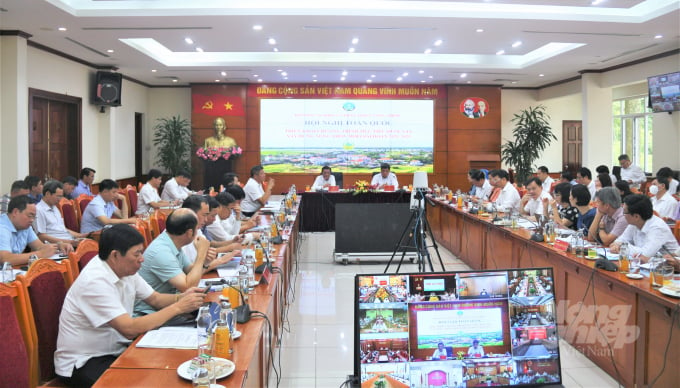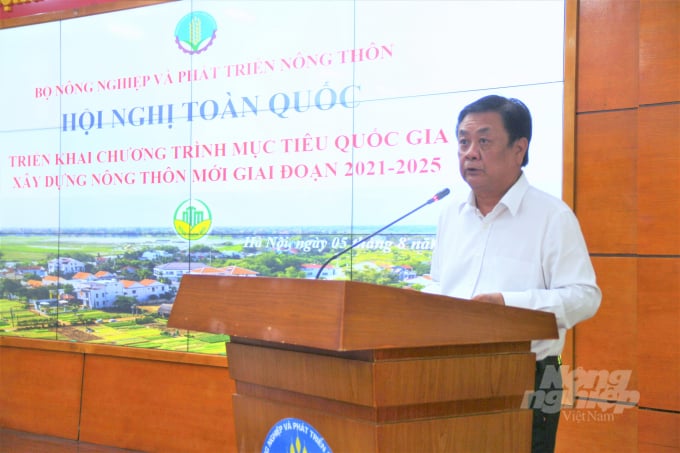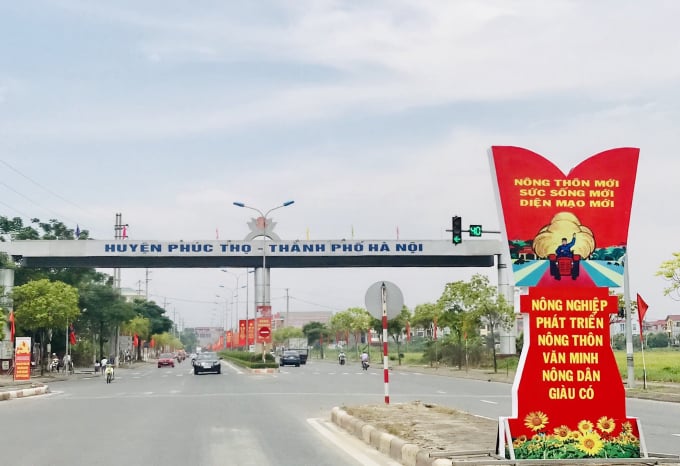May 19, 2025 | 09:04 GMT +7
May 19, 2025 | 09:04 GMT +7
Hotline: 0913.378.918
May 19, 2025 | 09:04 GMT +7
Hotline: 0913.378.918

The national online workshop to implement the National Target Program on building new rural areas from 2021 to 2025 was held on August 5. Photo: Pham Hieu.
The Ministry of Agriculture and Rural Development held a nationwide online workshop on August 5 to implement the National Target Program on building new rural areas for the period from 2021 to 2025.
Building new rural areas is one of the three National Target Programs expected to contribute to transforming agriculture, improving the quality of life for farmers and rural residents, as well as bringing sustainable values to rural areas in the modern world. The overall goal of the National Target Programs is that Vietnam will become an industrialized country in the direction of modernity by 2030.
After over 10 years of implementation, the program to build new rural areas for the past two terms has been assessed by the Party and State leaders as "comprehensive, significant and historic".
At the conference, Minister of Agriculture and Rural Development Le Minh Hoan raised 6 key issues for the National Target Program to effectively build new rural areas for the period from 2021 to 2025.
Firstly, the Minister ascertains that all documents including Resolutions, Decisions, Circulars and Guidelines are currently finalized and eligible for implementation. However, with the large volume of documents, including the guiding documents for the remaining 2 National Target Programs in the same area, different interpretations and different applications may arise. As a result, the Ministry of Agriculture and Rural Development is ready to listen and promptly respond so as not to obstruct the implementation process in different localities.

Minister Le Minh Hoan raised 6 key issues for the National Target Program to effectively build new rural areas for the period from 2021 to 2025. Photo: Pham Hieu.
Secondly, Minister Le Minh Hoan emphasized that the capital sources, including investment capital and non-business capital, will not be sufficient to develop a National Target Program that has both breadth and depth. That is, a Program that focuses on constructing infrastructure as well as developing the economy in combination with rural culture and society.
Namely, the Program focuses on forming spaces and institutions within rural communities in association with production spaces and rural economic development. Furthermore, improving the capacity and quality of life for rural residents under the National Target Program is particularly important.
“In addition to the central capital, localities need to integrate with local capital souces and call for socialization capital, attracting businesses to rural areas and allowing for start-ups to develop in the local rural areas. Many localities have reached the finish line ahead of schedule thanks to mobilizing non-budget resources from businesses and the participation of the people. In my opinion, each locality needs to develop a plan to attract resources, as well as closely accompany and support the grassroots level, "said Minister Le Minh Hoan.

In addition to the central capital, localities need to integrate with local capital souces and call for socialization capital. Photo: Phuong Hue.
Thirdly, the National Target Program on building new rural areas from 2021 to 2025 is designed not only to build a system of infrastructure, facilities, and institutions, but also to focus on economic development, preserving rural identity, promoting traditional culture, and improving community capacity in the rural society.
In other words, the Program closely and synchronously combines economy - culture and society in rural areas. These issues were not present in the past, but they will ensure the harmonious, sustainable, and rich development of the new rural areas, improve people's knowledge and quality of life by ensuring that they have access to education, healthcare, nutrition, gender equality and so on.
“I would like to emphasize once again that we need to change the approach to the Program with a new mindset, where infrastructure investment is not the main focus. However, we also need to pay special attention to the harmony and friendliness with the natural environment, village and rural space regarding the infrastructure itself. This goal can only be achieved if local leaders, especially those at the grassroots level, are more closely involved, to avoid following trends, and avoid conflict between urbanization and rural values", Minister Le Minh Hoan emphasized.
Fourthly, the Minister said that the Program cannot stereotyped across all localities. The image of new rural areas should be based on local traditional values, the specificity of each region, thereby diversifying planning ideas and rural landscape architecture.
The rural area is characterized by open space, people's interconnectedness, people's closeness to nature, so it is necessary to pay attention to the integration of construction and natural areas, creating living spaces for the community. the exchange and connection of rural residents and open access to urban areas.
Accordingly, Minister Le Minh Hoan hopes that localities will seize the opportunity to proudly introduce to the local image of 'rural heritage', as opposed to copying from elsewhere, stereotyping the new rural image. The Ministry of Agriculture and Rural Development also asked the Ministry of Construction to coordinate in organizing the annual awards for rural landscape planning and architecture in the immediate future.

The image of new rural areas should be based on local traditional values, the specificity of each region, thereby diversifying planning ideas and rural landscape architecture. Photo: TL.
Fifthly, production reorganization is a decisive factor in increasing farmers' income, reorganizing production on the basis of reorganizing rural society towards cooperation and association in production, preservation, processing, and trading of agricultural and craft villages' products. Rural economic development is a stepping stone to create job opportunities in rural areas according to the motto of "separation of agriculture, not separation of homeland".
Developing agricultural and rural tourism is an approach to attract urban people to the rural areas. For farmers, this is a way to introduce and promote the image of the village in association with the consumption of agricultural and craft village products. Agricultural and rural tourism can also serve to activate the change of rural lifestyle towards civilization. The Ministry of Agriculture and Rural Development has reorganized the community agricultural extension team to achieve various goals, including building and developing rural areas. The Minister has asked localities to pay attention to this issue.
Sixthly, in addition to the criteria of model and advanced rural areas, many localities have recently combined building Smart Villages, Happy Villages, and Cultural Tourism Villages among others.
“I appreciate these initiatives that make a difference and we will have a summary to perfect and replicate in the near future in suitable localities. The Agricultural Guild model in Dong Thap, the Farm Association model in Gia Lai, the House of Wisdom model in Ha Tinh, etc. have been evaluated for their effectiveness, helping to create a practical living space for the rural community. I hope that these models will be repicated throughout the country”, praised Minister Le Minh Hoan.
The National Target Program on building new rural areas expects that Vietnam will have at least 80% of its communes meeting the standards of new rural areas by 2025. Nearly 40% of the communes will meet the standards of advanced rural areas, and at least 10% of the communes will meet the standards of modern rural areas and no commune under 15 criteria; the average income of the rural residents will increase by at least 1.5 times compared to 2020.
In addition, the Program strives to have at least 50% of rural districts, towns and provincial cities meet the new rural standards, complete the task of building new rural areas. At least 20% of the districts will meet the standards of advanced rural districts, as well as model rural districts. Each province and city directly under the Central Government has at least 2 district-level units that will meet new rural area standards.
Additionally, the Program also aims to have 17-19 central provinces and cities recognized by the Prime Minister as completing the task of building new rural areas; 60% of towns, hamlets and villages in extreme poverty communes in border areas, mountainous areas, coastal flat areas and islands to be recognized as meeting new rural standards according to the rural development criteria regulated by the Provincial People's Committees.
The program aims to be deployed and implemented in rural areas with a of 8,227 communes (including 1,458 communes in Region III in ethnic minority and mountainous areas, 54 communes in extreme poverty in coastal and island areas), 644 district-level units with communes (including 74 impoverished districts) belonging to 63 central provinces and cities according to the provisions of the National Criteria for Rural Development from 2021 to 2025.
Translated by Nguyen Hai Long

(VAN) 14 out of 35 domesticated elephants in Dak Lak province have had their living conditions improved, with 11 of them currently participating in the non-riding elephant tourism model.

(VAN) Muong Nhe Nature Reserve hopes that being upgraded to a national park will lay the foundation for forest protection efforts to be carried out in a systematic, modern, and sustainable manner.
/2025/05/16/3923-2-171845_52.jpg)
(VAN) Lower costs, higher yields, and improved soil quality are outstanding benefits that soybeans bring when integrated into the crop rotation system.

(VAN) The 'For a Green National Environment' programme aims to promote a green lifestyle, support businesses in implementing ESG practices, and turn Net Zero commitments into concrete actions.

(VAN) Cold-barn systems efficiently manage environmental and temperature conditions, which aids in the prevention of respiratory diseases in pigs and protects them from the vectors that transmit African swine fevers.

(VAN) To tackle challenges, the project 'Addressing key technical bottlenecks in the grouper supply chain in Vietnam' has been underway since 2024.

(VAN) The project 'Disease-Resilient and Sustainable Cassava Production Systems in the Mekong Region', funded by the Australian Center for International Agricultural Research (ACIAR), is being implemented from 2024 to 2028.